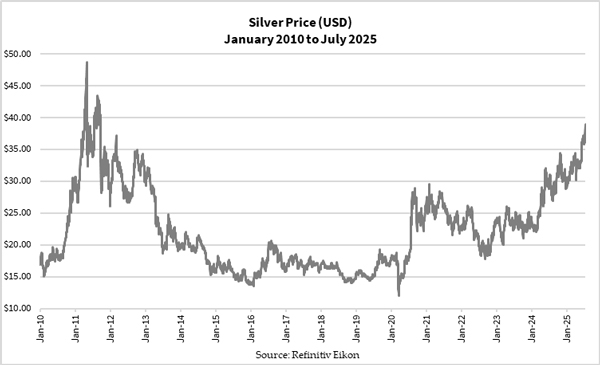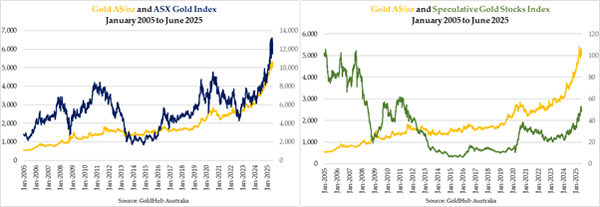Gold has delivered stellar performance in the last ten years. It tripled during this period, and more than doubled in the last five.
It’s also been getting a lot of media coverage in the past year because of its performance. People are increasingly aware of gold and taking it seriously, rather than dismissing it as an ancient relic.
However, gold is now facing tough competition from its more volatile and mercurial little sibling, silver.
Silver broke above US$39 an ounce on Monday, reaching a 13-year high:
| |
Silver pulled back to the 37-38-handle shortly after. But clearly this is a bullish setup.
What’s noteworthy is that gold pulled back last month after the Israel-Iran conflict de-escalated. But silver not only held its ground, it rallied higher. Let me show you the performance of the two precious metals since the start of June:
| |
Silver’s strong performance is causing a stir among precious metals enthusiasts. Especially those who believe that silver should be worth at least US$100 an ounce.
For that to happen, it first has to break above the current record of around US$50, which it set back in 1980 and 2011. It looks like that could happen in this cycle.
Silver stocks to capitalise on silver’s run? Not quite…
So, how do you capitalise on silver’s bullish setup?
Many have been wondering which silver stocks to buy. However, it’s slim pickings on the Australian Stock Exchange. There aren’t any major silver producers, and most silver mining companies are explorers. Their success depends on whether they find silver more than the silver price.
I have good news for you, though. You don’t have to buy silver stocks for exposure to silver’s surge.
Holding gold stocks, especially some of the explorers and early-stage developers, may do the job.
You might think that doesn’t sound right. Gold’s already taken off, and so have many gold stocks. Why am I double-dipping now?
What I’m about to show you is surprising!
The link between gold, silver and gold stocks – what the data says
Like many who buy gold and invest in gold stocks, I thought the two were closely linked.
I realised over ten years ago that gold producers would move with not the price of gold, but the relative price of gold and oil. This is because gold producers sell gold but spend quite a bit on oil to run their machinery. So, the profitability of mining companies depends on both of those prices.
My analysis showed that the gold-oil ratio was useful in predicting how gold producers perform in the next two quarters. That’s because the gold-oil ratio roughly estimates the operating margins of gold producers. A higher gold-oil ratio means gold producers should receive more from gold sales than what they spend on their operations.
Besides the gold-oil ratio, it turns out silver, rather than gold, has a stronger correlation with gold stock performance.
I studied the historical price movements between gold, silver, and gold stocks. For the more established gold stocks including producers and late-stage developers, I used the ASX Gold Index [ASX:XGD]. For the explorers and early-stage developers, I used my own Speculative Gold Stocks Index.
I split it into a few periods, marking the different stages of the gold price cycle.
Let me show you the figures for the price movements first:
| |
| |
Can you see how the gold stock indices moved more in line with silver than gold, especially in the past ten years?
The correlation analysis results below confirm this further:
| |
You can pretty much ignore the correlations before 2012 because it was before and during the massive currency creation following the subprime crisis.
However, the strong links between silver and the performance of gold stocks have been evident since 2013. It’s become even more closely linked in the last five years as our financial system looks to be on its last legs.
That’s the data. But why is this the case?
Money versus a leveraged trade against the system
If there’s one major misunderstanding about gold and gold stocks, it’s this.
Gold is money. It’s an asset that protects your purchasing power and a means to store your wealth.
Gold stocks are investments in businesses that explore, mine, and sell gold (and other minerals). They don’t protect purchasing power. They’re risky investments that rise and fall with the company’s fortunes.
What does this have to do with silver?
Let me show you this figure of how gold and silver moved in the past 25 years:
| |
Notice how gold is less volatile than silver. Gold tends to lead, while silver catches up quickly as gold peaks.
A simple way to express this is that silver is akin to a FOMO (fear of missing out) precious metal trade. People chase silver after seeing gold take off.
Gold stocks are leveraged bets on the performance of gold. These companies may flourish with gold rallying and go through rough patches when gold is in a bear market.
You can therefore imagine how investors may crowd into this space when gold has rallied for an extended time. They may chase silver at the same time as they perceive gold to offer less upside potential by then.
That’s why gold stocks are more correlated with silver. This is especially the case for the smaller gold stocks.
So, it’s over to you. Silver looks like it’s about to break into a rapid dash to catch up to gold. You can try to position yourself in a handful of silver stocks to capitalise on this potential breakout, like the rest of the market which aren’t well informed.
Or you can position yourself in a selection of gold explorers and early-stage developers, having learnt the little-known link that I showed you above.
The choice is yours.
God bless,
 |
Brian Chu,
Editor, Gold Stock Pro and The Australian Gold Report








Comments